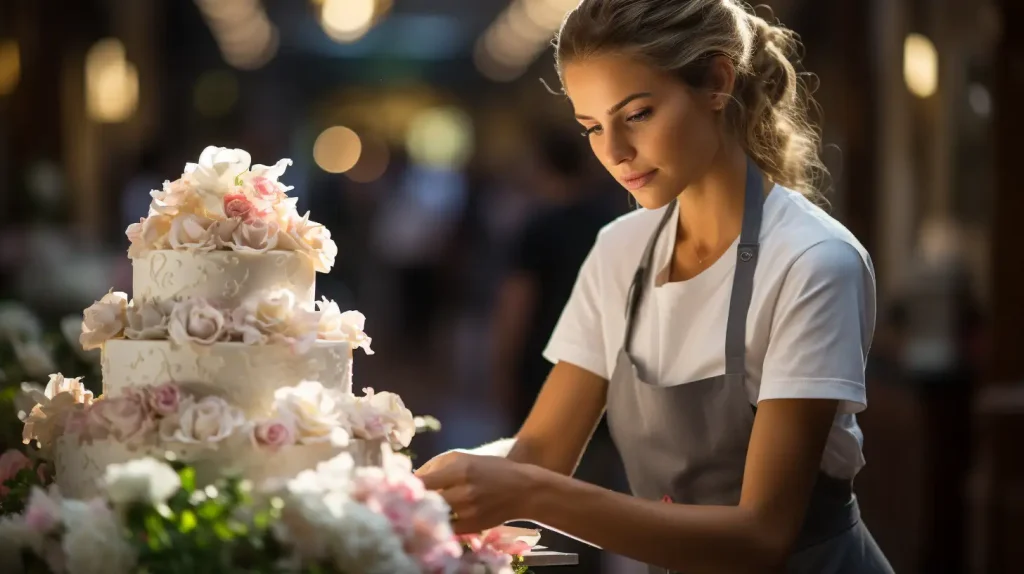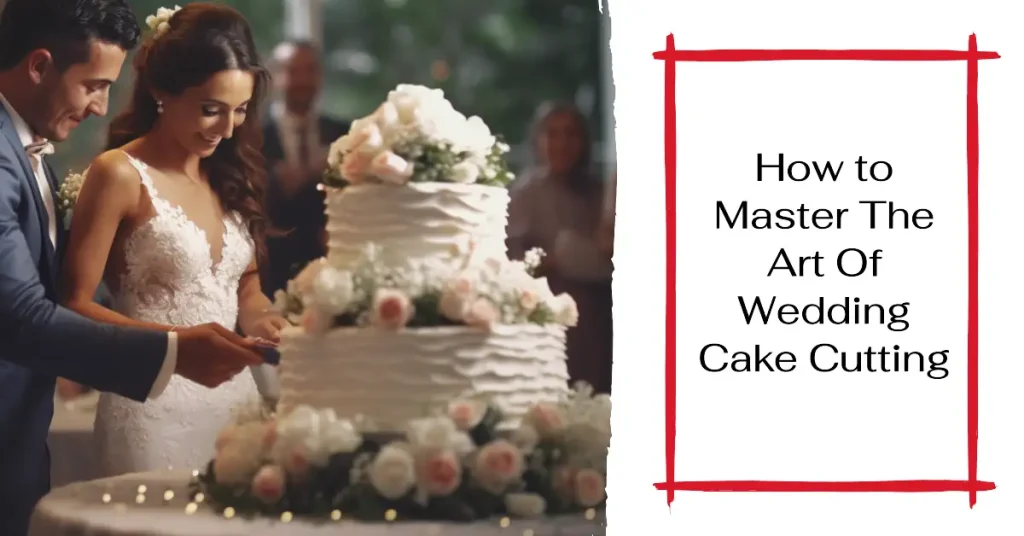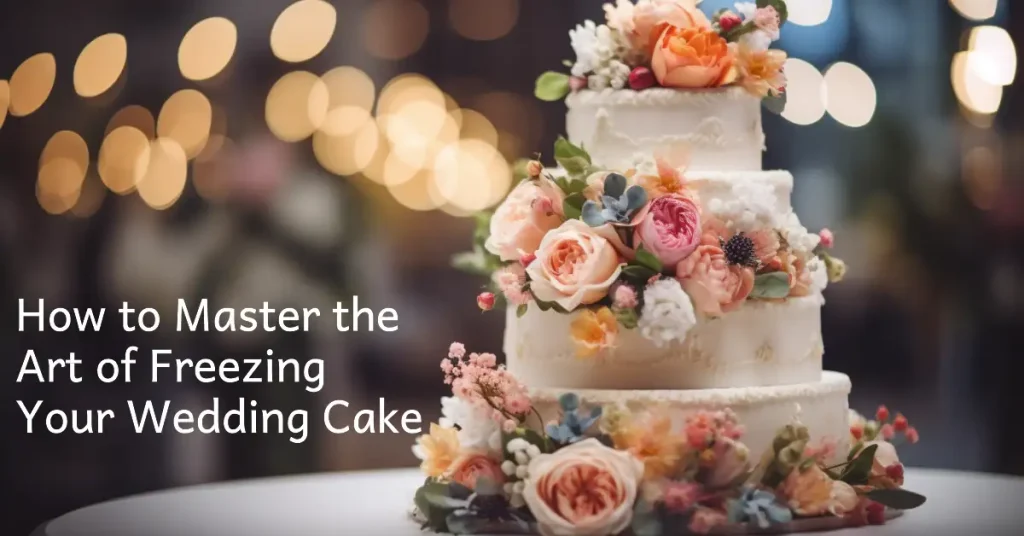Table of Contents
Transporting a wedding cake can be a daunting task, especially when it comes to ensuring that the cake arrives safely at its destination. As the centerpiece of a wedding reception, the cake’s appearance and taste are critical, and any damage during transportation could ruin the entire event.
That’s why it’s important to know how to transport a wedding cake safely. In this article, we’ll provide you with tips and guidelines on how to transport a wedding cake without compromising its integrity.
Key Takeaways
- The structure and fragility of a wedding cake make transportation challenging.
- Proper preparation and precautions are necessary for ensuring a safe delivery.
- Selecting the right vehicle and packing and securing the cake are crucial steps.
- Effective communication with the transportation team is essential.
- Unpacking and checking for any damage upon arrival are important final steps.
Understanding the Cake’s Structure and Fragility
Transporting a wedding cake is a delicate process due to the cake’s structure and fragility. Wedding cakes are typically multi-tiered and complex, making them vulnerable to damage during transportation. The slightest impact or shake can cause the cake to bend, crack, or even collapse. Therefore, understanding the cake’s structure and fragility is crucial to ensure a safe and successful delivery.
- Carter, Lisa (Author)
- English (Publication Language)
- 107 Pages - 04/06/2024 (Publication Date) - Independently published (Publisher)
Wedding cake transportation methods require a sturdy base and proper support to prevent any movement during transit. The bottom layer of the cake should be firmly secured to the base to prevent it from tipping over or sliding during transportation. Additionally, each tier should be stacked and secured with dowels or pillars to prevent them from shifting. These precautions will help maintain the cake’s structural integrity and prevent it from collapsing.
Cautious handling is also crucial when transporting a wedding cake. The cake should be handled with the utmost care and attention to prevent any damage. Any sharp movements, sudden stops, or turns should be avoided to prevent the cake from shifting or collapsing. It is recommended to have two people handle the cake during transportation, with one person holding the base, and the other person holding the top tier.
Understanding the Cake’s Fragility
The fragility of the cake is another crucial aspect to consider during transportation. Wedding cakes are usually decorated with intricate details and delicate frosting, which can easily be damaged during transit. Therefore, it is essential to ensure that the cake is kept in a stable environment and protected from any potential harm.
Extreme temperatures can also affect the cake’s condition, causing the frosting to melt or the cake layers to crack. To prevent this, the cake should be refrigerated before transportation and kept in a temperature-controlled environment during transport.
Preparing for Transportation: Precautionary Measures
Transporting a wedding cake can be a nerve-wracking experience, but with proper preparation, it can be done smoothly. Here are some precautionary measures to take before transporting the cake:
- Refrigeration: Ensure the cake is refrigerated adequately before transport to maintain its shape and prevent melting or spoilage.
- Assembly: Assemble the cake at the venue if possible to minimize the risk of damage during transport. However, if that’s not possible, ensure the cake is assembled properly and secured on a sturdy base.
- Securing the Cake: Use cake boxes, supports, and cushioning materials to secure the cake and prevent any damage during transit.
- Timing: Plan the transportation schedule to avoid traffic congestion or long journey times that could affect the cake’s stability.
- Backup Plan: Prepare a backup plan with your transportation team to handle unexpected situations, such as traffic jams or weather changes.
Refrigerating the Cake
Refrigeration is critical to maintaining the cake’s shape, especially during warmer weather. Be sure to chill the cake for at least an hour before transport, allowing it to set and solidify. Cover the cake loosely with plastic wrap or a cake dome to prevent any debris from touching the frosting. Additionally, it’s a good idea to transport the cake in an air-conditioned vehicle to maintain cool temperature and avoid melting.
Assembling the Cake
If possible, assemble the cake at the venue to minimize the risk of damage during transport. However, if that’s not possible, take proper precautions to assemble the cake securely. Start by placing the cake on a sturdy base and use dowels or straws to provide support. You can also apply a thin layer of buttercream between each cake layer to hold the cake’s layers firmly.
Securing the Cake for Transport
Securing the cake correctly is crucial to prevent any damage during transit. It’s recommended to use a cake box that fits the cake snugly. Fill any gaps between the box and the cake with crumpled parchment paper or bubble wrap. Use supports such as foam blocks or non-slip mats to prevent the cake from sliding during transit. Additionally, cushion the cake box with towels or blankets to absorb any shocks that may occur during transport.
Choosing the Right Vehicle for Transport
Transporting a wedding cake is not a task that can be done haphazardly or without any forethought. One of the most crucial factors to consider when transporting wedding cakes is choosing the right vehicle. The vehicle should be large enough to accommodate the cake, without the cake having to be squeezed in or placed in an awkward position.
It’s essential to consider the temperature in which the cake will be transported. The vehicle should have a stable temperature control system to prevent the cake from melting or becoming too cold. An air-conditioned vehicle is the best option to keep the cake at a stable temperature during transportation.
Recommended Vehicles for Wedding Cake Transportation
| Vehicle Type | Pros | Cons |
|---|---|---|
| Delivery Van | Spacious enough for larger cakes, temperature-controlled, closed compartment ensures safety. | May not be always available, requires advance booking, may be more expensive than other options. |
| SUV | Spacious enough for smaller cakes, temperature-controlled, available with a luggage carrier on top for larger cakes. | May not be spacious enough for larger cakes, requires careful driving. |
| Car | Easy to drive, temperature-controlled for small cakes. | Not spacious enough for larger cakes, may not have temperature control. |
It’s always important to keep in mind the stability of the vehicle while transporting a wedding cake. A vehicle with poor suspension or that is difficult to drive may not be suitable for transporting a cake. The stability of the vehicle is essential to ensure that the cake is secure while in transit, reducing the risk of any damage.
Choosing the right vehicle is an essential element in safely transporting a wedding cake. It provides peace of mind, knowing that the cake will arrive safely, ready to be displayed at the wedding.
Packing and Securing the Cake
When it comes to packing the wedding cake for transportation, it’s important to take all the necessary precautions to ensure it arrives intact and in perfect condition. Here are some tips to pack and secure the cake:
| Step | Details |
|---|---|
| Use a cake box | A sturdy cake box is essential to protect the cake from any potential damage or accidents during transit. The box should be slightly larger than the cake to ensure there’s enough space for supports and cushioning materials. |
| Support the cake | Use a sturdy cake base and supports inside the box to prevent the cake from shifting or collapsing during transportation. Wooden dowels or bubble straws can be inserted between the cake layers to provide additional support. |
| Cushion the box | Place the cake box securely in a larger box to provide additional cushioning and protection. Fill any gaps between the boxes with bubble wrap or packing peanuts to prevent movement during transit. |
| Label the box | Clearly label the cake box as “fragile” and/or “this side up” to ensure careful handling during transportation. It’s also important to include a contact name and phone number in case of any issues or questions during delivery. |
By following these steps, you can greatly minimize the risk of damage to your wedding cake during transportation. Remember, taking the time to pack and secure the cake properly is crucial to maintaining its structural integrity and ensuring a beautiful display on the big day.
Handling and Driving Precautions
Transporting a wedding cake requires careful handling and driving to ensure its safety. Here are some tips for safe transportation:
- Drive carefully: Avoid sudden stops, sharp turns, and speeding. Drive smoothly and slowly to keep the cake stable.
- Keep the cake level: Make sure the cake is positioned on a flat surface, and avoid any inclines that could cause it to shift or topple.
- Use caution on bumpy roads: If you encounter rough patches or potholes, slow down and navigate them carefully to prevent any damage to the cake.
- Secure the cake: Double-check that the cake is securely packed and anchored in the vehicle to prevent it from sliding or tumbling during transit.
- Avoid extreme temperatures: Keep the vehicle at a moderate temperature, avoiding excessive heat or cold that could affect the cake’s stability or texture.
- Stay focused: Keep your attention on the road and avoid any distractions or sudden movements that could impact the transportation of the cake.
By following these precautions, you can ensure that the wedding cake arrives at the venue safely and in perfect condition for the big day.
Communicating with Your Transportation Team
Effective communication is key when it comes to transporting a wedding cake safely. Make sure you are clear with your transportation team about the cake’s size, weight, and fragility. Provide them with detailed instructions on how to handle and transport the cake.
If you have any specific concerns or requirements, such as the need for temperature control or a particular route, let your transportation team know in advance. It’s important to establish good communication from the start to avoid any misunderstandings or mistakes.
On the day of transportation, make sure you communicate any changes in plan or unexpected situations promptly. If there are any delays or issues, inform your transportation team immediately so that they can adjust their plans accordingly.
Arriving at the Venue: Unpacking and Final Touches
Upon arriving at the wedding venue, it’s time to carefully unpack the cake and prepare it for display. Take note of any damage that may have occurred during transportation and make any necessary final touches.
Pro Tip: Before unpacking, inspect the cake thoroughly for any signs of damage or shifts in structure. If there is any damage, assess if it can be repaired on-site or if a backup cake is necessary.
If the cake has traveled a long distance, it may need some time to acclimate to the venue’s temperature. To ensure the cake remains fresh and doesn’t melt, place it in a temperature-controlled area or refrigerator until it’s time to display.
When it’s time to display the cake, carefully remove any packing materials and supports. Use a pastry brush to dust away any crumbs or debris that may have accumulated during transport.
Pro Tip: For large cakes or multi-tiered cakes, it’s a good idea to assemble them on-site to prevent any shifting or damage during transportation. This also ensures that the cake is properly aligned and looks its best for the big day.
Once the cake has been unpacked and assembled, add any final decorations or touches to make it truly special for the bride and groom. Take a moment to step back and admire your handiwork – you’ve successfully transported a beautiful wedding cake!
Dealing with Unexpected Situations
Sometimes, despite all the precautions, unexpected situations can arise during transportation. These can include traffic jams, car breakdowns, or extreme weather conditions such as high winds or heavy rain. In such situations, it is crucial to remain calm and take necessary steps to protect the cake.
Extreme Weather Conditions
If the forecast predicts inclement weather, it is important to take extra precautions. For example, if it is raining heavily, cover the cake with a secure plastic wrap to avoid water damage. If it is very hot outside, keep the car’s air conditioning on to maintain a cool temperature inside the vehicle. On the other hand, if it is extremely cold, make sure the cake is packed in a suitable box with proper insulation to protect it from frost and condensation.
Traffic Jams and Car Breakdowns
In case of unexpected traffic jams, inform the transportation team to make alternative route arrangements and avoid any further delays. If the car breaks down, immediately remove the cake from the vehicle and place it in a safe, cool area while waiting for a replacement vehicle to arrive. Ensure proper support and protection for the cake during the transfer from the malfunctioning vehicle to the new one.
Last-Minute Changes
It is not uncommon for last-minute changes to occur during weddings. In case of such changes affecting the transportation arrangements for the cake, promptly inform the wedding planner and transportation team to make necessary adjustments. Always prioritize the safety and integrity of the cake, and communicate any concerns or suggestions to the team to ensure a smooth and successful delivery.
Conclusion
Transporting a wedding cake can be stressful and tricky, but careful planning and following the guidelines can help guarantee a safe delivery. Remember to consider the cake’s structure, select a suitable vehicle for transport, and pack and secure the cake properly. Smooth driving and effective communication with the transportation team are also essential for a successful delivery.
Upon arrival at the venue, unpack the cake carefully, check for any damage, and make the final touches before display. Be prepared to handle any unexpected situations, such as extreme weather conditions or last-minute changes, to ensure the cake’s safety.
By following these steps and taking precautions, transporting a wedding cake can be a seamless and stress-free process, allowing the newlyweds to enjoy their special day with a beautiful and delicious dessert.
FAQ:
Q: How important is it to safely transport a wedding cake?
A: Safely transporting a wedding cake is crucial in maintaining its integrity for the big day. The cake represents a significant part of the celebration, and any damage during transportation could ruin the experience.
Q: What challenges are involved in transporting a wedding cake?
A: Transporting a wedding cake can be challenging due to its structure and fragility. The delicate nature of the cake requires careful handling and precautions to prevent any damage.
Q: What precautionary measures should be taken before transporting a wedding cake?
A: Before transporting a wedding cake, it is important to take precautionary measures such as refrigeration, proper assembly, and securing the cake to ensure a smooth journey.
Q: How do I choose the right vehicle for transporting a wedding cake?
A: When transporting a wedding cake, selecting a suitable vehicle is crucial. Consider factors such as size, temperature control, and stability to ensure the cake reaches its destination safely.
Q: How should I pack and secure the wedding cake during transportation?
A: It is essential to securely pack the wedding cake for transportation. Using cake boxes, supports, and cushioning materials can help prevent damage during transit.
Q: What precautions should I take when handling and driving while transporting a wedding cake?
A: When transporting a wedding cake, handle and drive with caution. Smooth driving, avoiding sudden stops or sharp turns, is necessary to maintain the cake’s stability.
Q: How important is communication with the transportation team?
A: Effective communication with the transportation team is vital for a successful and safe delivery. Clear instructions and coordination are necessary to ensure the cake arrives intact.
Q: How should I unpack and make final touches to the cake upon arrival at the venue?
A: Upon arriving at the venue, carefully unpack the cake and check for any damage. Make necessary final touches to ensure the cake is ready for display.
Q: How should I handle unexpected situations during wedding cake transportation?
A: In case of unexpected situations such as extreme weather or last-minute changes, it is important to remain calm and follow the provided tips to ensure the cake’s safety.






